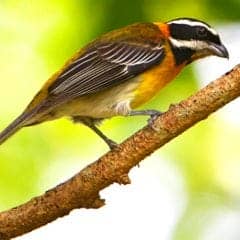
| Animalia | Passeriformes | Spindalidae | Spindalis | Spindalis portoricensis |
The Puerto Rican Spindalis (Spindalis portoricensis) is a striking 17 cm songbird, nicknamed “queen blackbird” locally for the male’s jet-black head and vivid orange-green plumage.


- Common Name(s): Puerto Rican Spindalis, Queen Blackbird, Reina Mora
- Family: Fringillidae
- Body Dimensions: 17 cm
- Male Plumage Color(s): Green Upperparts, Orange Neck and Chest, Black Head With White Stripes
- Female Plumage Color(s): Olive Green With Less Distinct Head Pattern
- Habitat: Forests and Plantations
- Diet: Fruit, Insects
- Native Countries: Puerto Rico
- Continent(s): North America
- Taxonomy Classification Year: 1997
- Taxonomist(s): Henry Bryant
Puerto Rican Spindalis Fun Facts

- Once considered a subspecies of the Western Spindalis, this endemic taxon merits distinction as Puerto Rico’s unofficial national bird based on its unique vocalizations and morphology[1].
- Inhabiting forests island-wide, the frugivorous Puerto Rican Spindalis supplements its diet of fruit like figs and cordia with opportunistic insects.
- Highly social, these birds travel in small flocks while foraging and even mob predators like boas to defend collective territory.
- A cup-shaped nest woven from grasses and leaves in dense vegetation nurtures light blue eggs etched in brown. While comfortable in human-altered habitats, this adaptable species struggles with Habitat Loss and nest predation like most endemics.
- Classified[2] as Least Concern but experiencing an ongoing population decline, the beleaguered Puerto Rican Spindalis epitomizes the delicate balance endemic species navigate.
- Even generalist birds relying more on cultivated fruits face precarious futures if climate change and urbanization erase the remaining sanctuary.
Ensuring adequate protected rainforest, controlling invasive species, and sustaining agricultural lands could support stable Puerto Rican Spindalis populations.
But the island must honor its unofficial national bird by tackling habitat loss head-on before the queen blackbird’s kingdom disappears.
Cite This Page
APA7MLA8Chicago
BioExplorer.net. (2024, December 21). Puerto Rican Spindalis. Bio Explorer. https://www.bioexplorer.net/animals/birds/puerto-rican-spindalis/.
BioExplorer.net. "Puerto Rican Spindalis" Bio Explorer, 21 December 2024, https://www.bioexplorer.net/animals/birds/puerto-rican-spindalis/.
BioExplorer.net. "Puerto Rican Spindalis" Bio Explorer, December 21 2024. https://www.bioexplorer.net/animals/birds/puerto-rican-spindalis/.
















